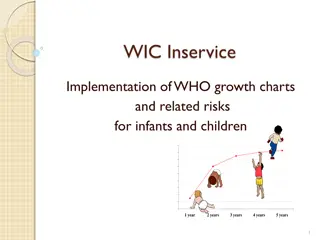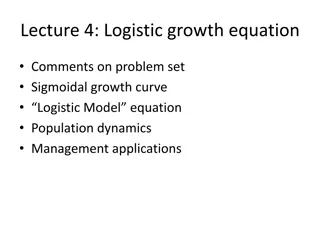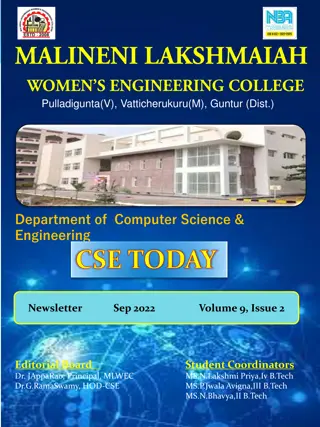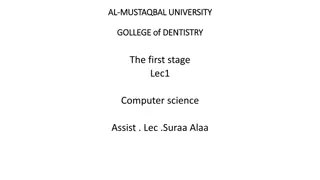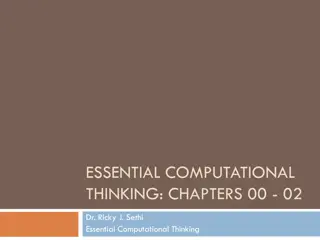Assessing Computer Science Undergraduate Enrollments Growth
The findings by Eric Roberts on the growth of computer science undergraduate enrollments, as outlined in the National Academies report, show a significant increase in bachelor's degree production in the field. The data reveals variations in growth rates based on institution type, with research-intensive universities and those offering master's degrees experiencing more rapid growth. Various factors influence the growth trajectory, such as degree constraints and institutional characteristics. The report also highlights fluctuations in degree numbers over time, with notable declines in certain periods.
Download Presentation

Please find below an Image/Link to download the presentation.
The content on the website is provided AS IS for your information and personal use only. It may not be sold, licensed, or shared on other websites without obtaining consent from the author.If you encounter any issues during the download, it is possible that the publisher has removed the file from their server.
You are allowed to download the files provided on this website for personal or commercial use, subject to the condition that they are used lawfully. All files are the property of their respective owners.
The content on the website is provided AS IS for your information and personal use only. It may not be sold, licensed, or shared on other websites without obtaining consent from the author.
E N D
Presentation Transcript
Sharing lessons on COVID-19 and PHC strengthening SUNANDA RAY & BOB MASH AFRICAN JOURNAL OF PHC&FM PRIMAFAMED 28 OCT 2020
Invitation to submit articles on PHC response to Covid-19 We asked for descriptions of innovations and descriptions of best practices in PHC and FM, including the contributions of family physicians, the management of C-19 in district health services and responses of communities to the outbreak Twenty-seven papers from six countries (Botswana, Ghana, Nigeria, South Africa, Uganda, Zimbabwe) were published as part of a special collection.
Community Oriented Primary Care (COPC) Mobilising public health and PHC sectors to work together (ideas + action) A prior commitment to in Cape Town to COPC with its links to primary care facilities, delineated geographic areas and network of community health worker (CHW) teams, facilitated an adaptive community-based response to the C-19 outbreak. Uganda decentralized health services, village health teams, CHWs Public health mobilization for health promotion at community levels sensitization, hygiene, enforcement of no gatherings
Social mobilization should be top of the agenda The essence of a lockdown is to deprive citizens of their freedom and their agency which risks treating them like prisoners or children, fuelling sentiments of powerlessness, resentment and fatalism, which do little to change behaviour. Lockdowns have disrupted people s daily wages and livelihoods, threatening their survival, and undermining trust and confidence in their governments. Failing to address people s legitimate concerns will promote more resistance .
Role of community health workers (Uganda, SA) In SA: CHWs assisted with screening of communities. efforts at community screening was made obsolete by the increasing TOT as cases and contacts could not be followed up in time. CHWs were then asked to screen households in their area, but only refer for testing people aged over 55 years with symptoms or co- morbidities. In SA CHWs delivered medications, non-pharmaceutical equipment and supplies for people with co- morbidities to their homes, thus protecting them from potential exposure at primary care facilities (184,000 parcels delivered in first month). Uganda: Neglect of the role of CHWs and VHTs in health education. These would have been instrumental in household-level health education, for example, regarding social distancing within the household. No community based screening.
Uganda response to the epidemic has not had PHC at the forefront Focus was more on providing critical care at central hospitals (ventilators etc) so the opportunity to address stigma and fear as well as to educate the public was lost Also did not use private sector as a resource to educate in primary care
Re-organising provision of care in PHC and district hospitals decongest services - free up capacity to respond to the expected surge of patients with C- 19 and reduce risk of nosocomial infection. separate patients into PUIs with respiratory symptoms in a hot stream and those without any symptoms into a cold stream. In both streams patients with minor ailments were treated and discharged as soon as possible. infection control methods: hand washing/sanitisation, physical distancing, use of face masks for patients and use of PPE as appropriate. rapidly built C-19 testing and treatment centres constructed from prefabricated structures, containers and tents outside the entrance.
Screening and testing DIFFICULTIES Procurement of test kits Use of antibody tests with lower sensitivity Long turnaround times at laboratories Limited by number of labs with capacity to screen Self-screening of nurses with symptom checklist ineffective Suggested self-testing with nasopharangeal swabs to reduce need for PPE and exposure for HWs
Appropriate critical care at district hospitals (Kenya, Zimbabwe) establishing early warning systems for hypoxia in patients with COVID- 19 acquiring oximeters, oxygen concentrators, and training health staff in fundamentals of critical care securing oxygen supplies through Assist International, and the Lifebox Scheme for oximeters, promoted through international partnerships such as the World Federation of Societies of Anaesthesiologists resources would continue to be useful in supporting emergency care in district hospitals for emergency surgical, obstetric and newborn care
Family physicians running critical care at the Hospital of Hope CTICC values included: upholding the humanity of their patients despite the industrial nature of their environment emphasizing clear leadership and planning close multidisciplinary teamwork continuity of care commitment mutual trust frequent communication with team and patients willingness to adapt and learn
Care of the vulnerable (Nigeria, Uganda, SA) Need for strategies on identifying disadvantage and inequalities, and guidelines on providing targeted services for vulnerable groups impact of social isolation due to physical distancing on older persons and those with mental health conditions and those on medication for HIV or chronic illnesses. Shielding of elderly family members at home reduced waiting times and triage Humanitarian aid food parcels, especially for elderly and pregnant women Pensioner associations and NGOs
Maintaining essential non-C19 services The World Health Organization warned that malaria deaths could double from 2018 if the focus on C- 19 disrupted interventions for malaria. Stigma and fear associated with C- 19 prevented access to care for malaria (Zimbabwe) Solutions integrate services, to utilise senior medical students and other task shifting measures, such as using NGO partners and non-health government workforce. extension of review periods for stable NCD patients; medication refills at pharmacies without doctor s consultation
Use of information technology Web-based games and videos were promoted (for those who could afford internet) which assisted people to manage lockdown and social isolation through physical exercise to prevent weight-gain and to maintain good psychological well-being (also for NCDs) remote access through use of telemedicine and toll-free phone lines Patient education via Whats App audio messaging was also suggested for people with diabetes who were at higher risk of severe C-19 disease to avoid exposure, also to request home delivery of medication
Adaptation of clinical learning environment for MMed FM registrars: Botswana and South Africa alternative learning outcomes in epidemic preparedness, emergency planning, surveillance and infection control development of patient management algorithms for C-19 care knowledge synthesis from emerging scientific literature; and for working with Ministries of Health on strategy and policy development and documentation Flexibility with timetables also allowed registrars to use elective and self-directed learning periods to catch up on care for other conditions, even using web-based platforms to do this concerns that registrars would not meet their case-work requirements and timelines for activities experience of the roles family physicians play in district health systems Adapting in response to a crisis is a key skill to be learnt, recognising that over-centralising control may lose the opportunity to build capacity at district levels and for active experiential learning virtual learning platforms












